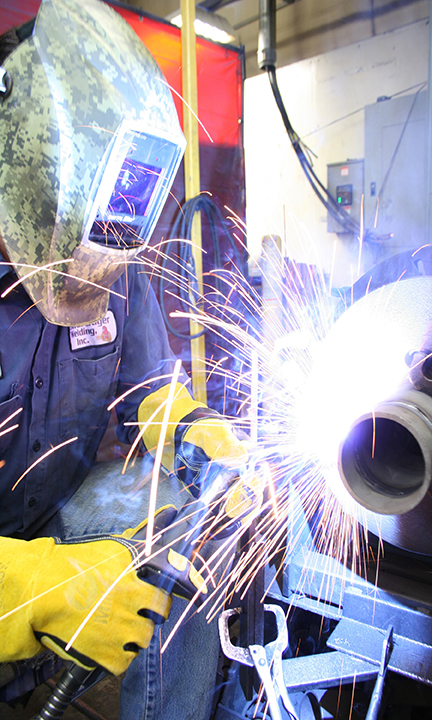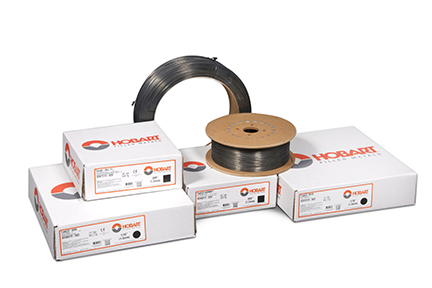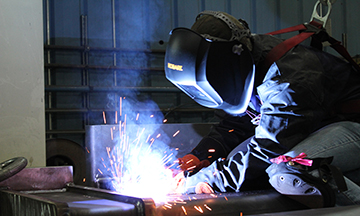Implementing a New Welding Wire Can Offer Productivity, Quality Benefits and More
Companies implement new technologies in their welding operations for any number of reasons — from gaining greater productivity and improving weld quality to saving money or improving the health and safety of welding operators. In some cases, these technology changes require capital investment for new equipment, while other times the introduction of a new welding wire may be the solution. A new wire is, without question, a much less expensive change to make; however, it can still yield significant advantages for the overall welding operation. To gain the best results, consider some common best practices for converting to a new wire.

quality, and enhanced health and
safety for welding operators are a few
of the benefits that can result from a
welding wire change.
Reasons to consider a change
As with any change in the welding operation, converting welding wires should not be undertaken without careful planning or without reason. Working with a trusted welding distributor or filler metal manufacturer can help in the assessment and the implementation. Some of the goals that can drive a wire change include:
Improving productivity: Some welding wires offer higher deposition rates and travel speeds, which can help increase productivity.
Addressing quality issues: A company that is dealing with quality issues may look to a wire change to address weld defects and rework. Wires with low diffusible hydrogen levels, for example, can help mitigate cracking risks in the right application.
Reducing weld fumes: Many companies are looking for wire options that reduce welding fumes and better protect their employees. Per the Occupational Safety and Health Administration, elimination or substitution is the first step in the Hierarchy of Controls to eliminate weld fume hazards — for example, by replacing an existing product with low manganese wires.
Cost savings: Cost can be a factor in a welding wire change — either a change to a less expensive wire or a conversion to one that allows the use of a less expensive shielding gas. It is also important to consider that some products, like metal-cored wires, can cost more upfront but offer long-term savings by increasing travel speeds, reducing spatter and minimizing pre-weld cleaning, especially compared to solid wires. These benefits can result in greater productivity, fewer instances of rework, less time for grinding before welding (due to the wires’ ability to weld through mill scale) — and a better bottom line.
Equipment setup
When a company makes a decision to change its welding wire, it is important to determine how the new wire differs in operation from the one previously used. This information can typically be found by comparing the operating parameters on a filler metal manufacturer’s recommendations and data sheets. For instance, different types of wires may operate on different polarities, which directly impacts the welding process and completed weld. A wire operating on electrode positive (EP) polarity focuses more of the welding arc heat on the base material to provide deeper penetration, whereas electrode negative (EN) polarity directs more of the arc heat on the wire itself, burning it off faster and providing higher deposition rates. Typically, solid wires and flux-cored wires — especially gas-shielded varieties — operate on direct current electrode positive (DCEP) polarity. Some self-shielded flux-cored wires may run on direct current electrode negative polarity (DCEN). Always be sure to use the correct polarity setting for the wire. It is also important to consider the mode in which a wire operates, as there may be equipment changes needed, for example, to adjust from MIG welding to pulsed MIG welding to gain the most from a new product. In this situation, be aware of the proper wire feed speed and voltage for the wire and process. Space considerations may also come into play when converting to a new wire, particularly if it is packaged in larger drums or spools and requires a larger footprint in the weld cell or in the storage area. Companies should plan accordingly for this extra space. Also, consider the available footprint if a new and larger power source is necessary to operate the wire.

and consumables, such as the welding gun, drive rolls, cable liner and
contact tips. The formula for success when using wire processes starts
with choosing the right style and size of consumables for the job.
Choosing components and consumables
Changing wires also requires a change in equipment components and consumables, such as the welding gun, drive rolls, gun liner and contact tips.
If it is necessary to implement a different welding process to operate a different wire, it may require more current as well. In this case, using ahigher-amperage welding gun can help dissipate the extra heat and prevent damage from overheating.
When selecting the size and type of drive roll, consider the size and type of wire being used for the application. Since flux-cored wire and metal-cored wire are softer (due to the flux inside and the tubular design), these require a knurled drive roll; this type of drive roll has teeth to grab the wire and help push it through for consistent feedability. Note that knurled drive rolls should not be used with solid wire, because the teeth can shave the wire, leading to clogs in the liner and premature wear of the front-end consumables. Instead, use a smooth V-groove drive roll with solid wire to avoid this problem.
In order to gain the best performance, companies may also need to change contact tips when implementing a new wire. The contact tip size should match the wire size to minimize problems with arc instability, wire stubbing and burnback. For example, a switch from solid wire to metal-cored wire may mean an increase in the wire diameter size, which would also require an increase in the contact tip size.
Similar considerations must be made when selecting cable liners. The size of the liner should match the wire diameter. If the liner is too big, the welding wire can slip and move, causing erratic wire feeding and an instable arc. Conversely, if the liner is too small, the wire won’t feed properly, also leading to wire feeding problems.
Lastly, depending on the welding process and the wire, a different shielding gas may be needed to avoid poor weld quality and/or defects that require rework. For example, when converting a MIG welding process with solid wire to a pulsed MIG process with metal-cored wire, it is necessary to use a shielding gas mixture with a higher percentage of argon — such as 90 percent argon with a 10 percent carbon dioxide mix — for the best results.

change in welding wires and the overall process can help
foster buy-in and acceptance for a smoother transition.
Proper operating techniques
The type of wire being used and the welding position also impact the recommended welding technique for an application. For most solid and metal-cored wires, a push technique is recommended, while for most flux-cored wires, a drag angle is recommended. A good rule of thumb: If a wire produces slag, a drag technique is typically the best choice. When welding out-of-position with solid or flux-cored wire, for example, a weave technique — or a slight back and forth motion — may be needed to achieve proper tie-in at the toes of the weld. Flux-cored wires may be more forgiving, and a weave technique may not be necessary to achieve the same results. Operating parameters may also need to change when implementing a new wire. Different wires may require different voltages, for example, and provide varying deposition rates. A wire with a higher deposition rate typically requires a faster travel speed, while one with a lower deposition rate requires a slower travel speed.
Training and procedure qualifications
Just as the proper equipment and consumables are key to successfully implementing a new wire, providing training and resources for welding operators is another important step that can help improve success. Involving welding operators in discussions about a potential change in the process can help foster buy-in and acceptance for a smoother transition. Depending on the code specifications followed for a certain application, it might also be necessary to seek requalification with the new wire. This process may require additional testing to ensure the weld meets the necessary specifications.
Verify the results
With thoughtful planning and consideration of these key issues, a welding wire change can improve productivity, quality and cost savings. Making the decision to change the welding wire or process, however, is not the end of it. Continuously evaluate the overall operation to ensure changes are producing desired results. If not, there may be additional steps to take to ensure success. When in doubt, consult with a trusted filler metal manufacturer or welding distributor.



